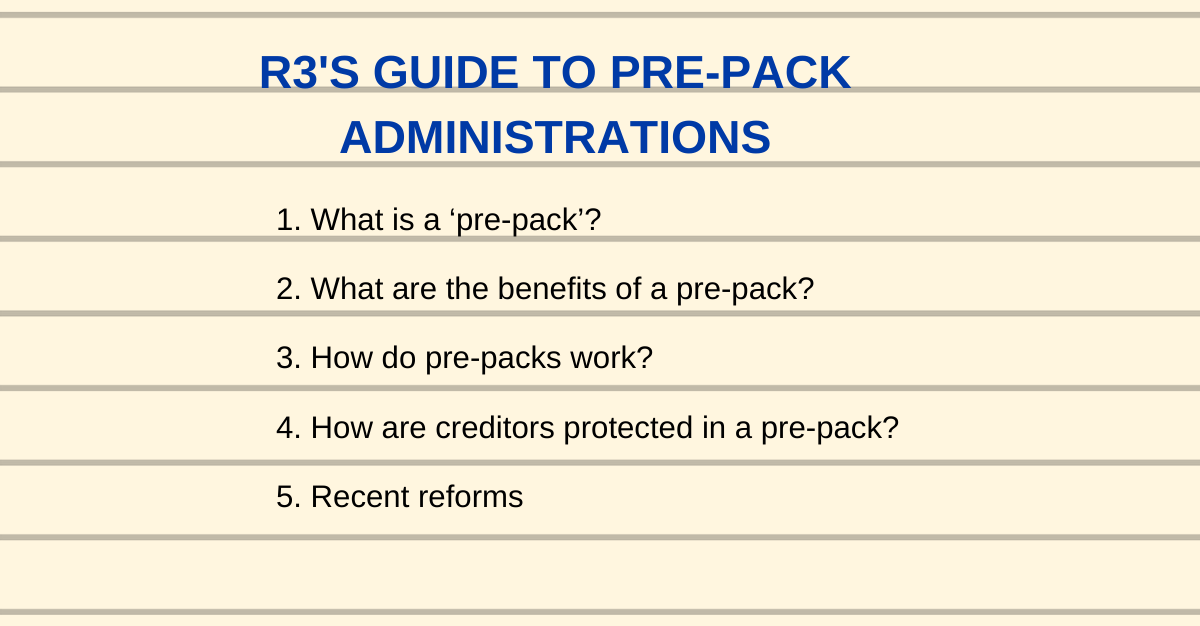
Quick guide to pre-pack administrations
15 March 2019
1. What is a ‘pre-pack’?
2. What are the benefits of a pre-pack?
3. How do pre-packs work?
4. How are creditors protected in a pre-pack?
5. Recent reforms
What is a ‘pre-pack’?
A ‘pre-pack’ administration is where the sale of an insolvent company’s business and/or assets is arranged before the appointment of an administrator (an insolvency practitioner) and then completed shortly after the appointment is made. Proceeds from the sale are used to repay the company’s creditors.
Creditors are notified once the sale is complete and provided with a detailed report on the pre-pack. The report explains why the pre-pack took place, why the pre-pack was a better option than alternatives, and how the business or assets were marketed before the sale.
Pre-packs can only take place when:
a) A company is insolvent, and;
b) An insolvency practitioner agrees a pre-pack is the means of achieving the best possible returns for the company’s creditors.
All pre-packs are overseen by a licensed insolvency practitioner. The insolvency practitioner is responsible to a company’s creditor body as a whole, not its directors nor one particular creditor.
A pre-pack may involve a sale to someone (e.g. a director) connected to the insolvent company. This is known as a ‘connected party pre-pack’.
There were just over 350 pre-packs in 2017 (latest available figures) – equivalent to around one-in-four administrations (and around 2% of all corporate insolvencies).
What are the benefits of a pre-pack?
Pre-packs help protect the value of an insolvent company’s business or assets for creditors.
The point of a pre-pack is to maximise what can be repaid to an insolvent company’s creditors by obtaining the maximum sale price of a company’s business or assets. Once it is publicly known how much difficulty a company is in, its value falls: key staff may leave, customers may cancel orders, and the brand may be hurt. The speed and discretion of a pre-pack therefore help protect value for creditors by achieving a sale before the value of a company’s business or assets are damaged.
In order to be used, a pre-pack must generate a better return for creditors than any alternative. The administrator must show in their report to creditors that a pre-pack was the best option in the circumstances.
Pre-packs allow businesses to recover from financial difficulties and save jobs. A business’ failure and redundancies can have a negative impact on local economies.
Pre-packs are over quickly. This keeps costs down compared to other insolvency procedures and means more money can get back to creditors.
How do pre-packs work?
1. A company is insolvent and calls in an insolvency practitioner for advice (a company’s secured lenders can also call in insolvency practitioners). It is decided that a pre-pack is the best possible option for the company’s creditors.
2. The insolvency practitioner must comply with the requirements and principles of Statement of Insolvency Practice (SIP) 16, which governs pre-packs. SIP16 includes rules on protecting creditors and marketing and valuing a company’s business or assets prior to a pre-pack. SIP16 is set by the Joint Insolvency Committee, a panel made up of regulators and other business bodies.
3. The company’s business or assets are valued and marketed (in line with SIP16), and a sale is lined up. In some cases, it may be that a sale to a ‘connected party’ (e.g. the previous owners) will lead to the best deal for creditors.
4. The company enters administration and, as arranged, its business and/or assets are sold. Any money raised from the sale is used to repay the insolvent company’s creditors. Purchasers may also agree to pay a proportion of future profits back to the creditors of the old company, if the new company is more successful than anticipated.
5. Creditors are treated equally by insolvency practitioners but are repaid in a strict hierarchy set out by government:
1. Secured creditors (e.g. mortgage lenders);
2. Costs of the insolvency process (e.g. rent or professional fees);
3. ‘Preferential’ creditors (this includes certain employee payments e.g. wage arrears);
4. ‘Floating charge’ creditors. A proportion of funds available to floating charge creditors (up to £600,000) can be repaid to unsecured creditors;
5. Unsecured creditors (e.g. trade creditors or HMRC);
6. Shareholders.
The amount of money repaid to creditors depends on the value of the insolvent company’s business and assets.
6. In any insolvency procedure, the insolvency practitioner will make a report to creditors. In a pre-pack, this report has to be made within seven days of a sale taking place. SIP16 requires the insolvency practitioner to explain why the pre-pack took place and what steps were taken to comply with SIP16. You can find the reports on the Companies House website here.
7. If the insolvent company’s business or assets are sold to a ‘connected party’, the purchaser has the option to refer the pre-pack to the ‘Pre-pack Pool’ before any deal is completed. The Pool is an independent group of business experts, one of whom will provide an opinion on whether the case for the pre-pack has been effectively made. The Pool is there to provide creditors with further assurance – beyond that provided by the insolvency practitioner – that the case for a pre-pack has been made. Details of any approach to the Pool (and its opinion) should be included in the administrator’s report to creditors.
How are creditors protected in a pre-pack?
All pre-packs are overseen by a licensed insolvency practitioner. Insolvency practitioners are answerable to creditors and have a duty to maximise returns to creditors and to comply with the requirements of SIP16. Failure to fulfil their obligations can lead to regulatory penalties for the insolvency practitioner, including fines and the loss of their licence. Creditors have the option to seek the replacement of the administrator, too.
Creditors can read the administrator’s report for information on what steps have been taken in the pre-pack and complain to the insolvency practitioner’s regulator if necessary.
The Pre-pack Pool can review connected party pre-packs to provide independent assurance that the case for the pre-pack has been made. Creditors should check administrators’ reports for details of any approach to the Pool.
The administrator has the power to investigate directors’ actions and refer any wrongdoing to the Insolvency Service. If the directors are determined not to have acted in creditors’ best interests they can be disqualified from acting as a director for up to 15 years.
Recent reforms
In 2013, the government commissioned Teresa Graham OBE to examine ‘the full economic impact of the [pre-pack] process’, including creditor worries about pre-pack transparency. Graham’s review, published in summer 2014:
- Concluded ‘there is a place for pre-packs in the UK’s insolvency landscape’ and that ‘the benefits that pre-packing brings to the UK’s insolvency framework mean that reform of the process is worthwhile.’ The review also said that pre-packs help save jobs and are cheaper than alternatives.
- Called for improvements to the transparency, marketing and valuation of pre-packs and for connected party purchasers to do more to demonstrate the viability of pre-packed companies.
- Made six recommendations for reform, including improving the marketing and valuing of businesses/assets ahead of pre-packs and the introduction of the Pre-pack Pool.
All six recommendations were introduced by November 2015 (via the launch of the Pre-pack Pool and the publication of a revised SIP16).
Other types of insolvency procedure
If a company cannot pay its debts when due or if its liabilities exceed its assets (i.e. the company is insolvent), it will enter an insolvency procedure most likely to maximise returns to the company’s creditors. An office holder or supervisor will be appointed to oversee the procedure and is responsible for maximising creditor returns.
There are four main corporate insolvency procedures:
Administration – Primarily designed to rescue a business or company. The office holder (an administrator) will run a company and its business while looking for a buyer or new investment, or while a restructuring takes place. The company may be rescued completely with new investment or a restructure, or parts of the business may be sold in full or in part to a new company and the insolvent company liquidated.
Company Voluntary Arrangement – Where an insolvent company agrees to repay its creditors a proportion of its debts over a set period of time. In most cases trade will continue with payments to creditors being made from trading receipts. An insolvency practitioner supervises the arrangement and the directors remain in charge.
Creditors’ Voluntary Liquidation (CVL) – Companies are liquidated when there is no prospect of rescue. The directors will seek to appoint an insolvency practitioner to act as liquidator of the company and to supervise the winding up of the company’s affairs. The company’s assets are sold to raise money to repay creditors.
Compulsory Liquidation – As above, but the company is placed into liquidation by the court. This can be on the petition of the company’s creditors or directors. The Official Receiver is automatically appointed liquidator, although the creditors have the opportunity to appoint an insolvency practitioner of their choice to act as liquidator in place of the Official Receiver.
Please note bankruptcy in the UK refers to the specific (and least common) personal insolvency procedure.
R3 members can provide advice on a range of business and personal finance issues. To find an R3 member who can help you, click below.

 Stuart McBride
Stuart McBride Amelia Franklin
Amelia Franklin Lyle Horne
Lyle Horne
